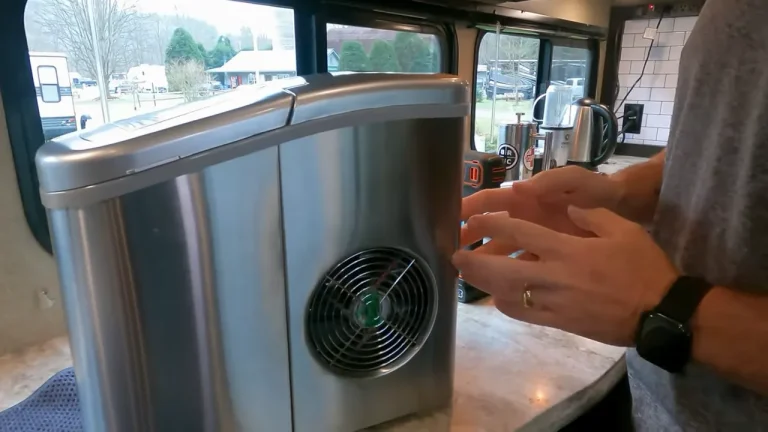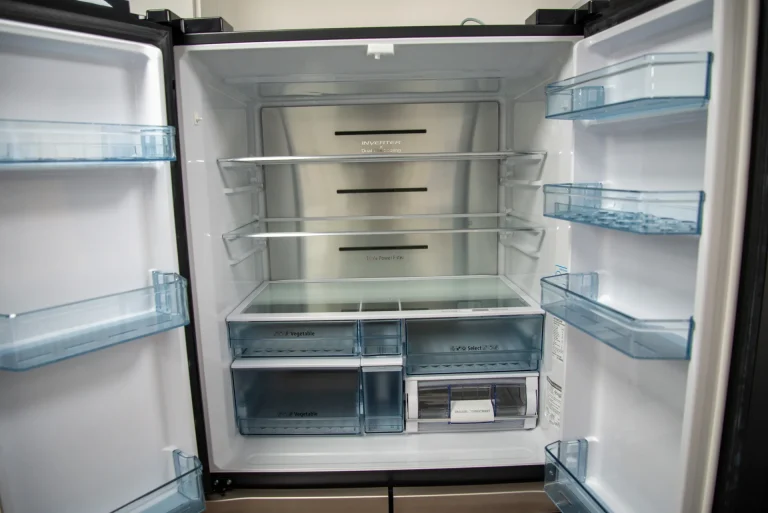Whirlpool Refrigerator Water Filter Replacement Troubleshooting [Solution]
Clean and pure drinking water is a fundamental necessity for every household. Whirlpool refrigerators have long been trusted to provide not only chilled refreshments but also filtered, crystal-clear water. However, even the most efficient water filtration systems require regular maintenance, particularly when it comes to replacing the water filter. This crucial task ensures that the water you consume remains free from contaminants and maintains its quality.
In this guide, we will walk you through the essential steps and troubleshooting tips for replacing the water filter in your Whirlpool refrigerator. From addressing common issues like leakages and water quality concerns to understanding the nuances of filter compatibility, we’ve got you covered. By the end of this article, you’ll have the knowledge and confidence to maintain a steady supply of clean, refreshing water for you and your family.
Let’s dive into the world of Whirlpool refrigerator water filter replacement troubleshooting, ensuring that your appliance continues to serve you with water that is not only cool but also impeccably pure.
Whirlpool Refrigerator Water Filters
Water filtration lies at the heart of every Whirlpool refrigerator, ensuring that the water dispensed is not only cool but also impeccably clean. To comprehend the replacement process, it’s vital to first grasp the fundamentals of these filters.
Types of Filters
Whirlpool refrigerators typically utilize two main types of water filters: activated carbon filters and reverse osmosis filters.
1. Activated Carbon Filters: These are the most common type and work by adsorbing contaminants onto a porous surface. They excel at removing impurities like chlorine, sediment, and volatile organic compounds (VOCs).
2. Reverse Osmosis Filters: These filters employ a semi-permeable membrane to eliminate a broader range of contaminants, including heavy metals, minerals, and microbial contaminants.
How the Filtration System Works
The filtration process begins when water enters the refrigerator through the inlet valve. From there, it flows through the filter, which contains the filtering medium. The activated carbon or reverse osmosis membrane traps impurities while allowing clean water to pass through.
Recommended Replacement Schedule
To maintain optimal filtration performance, it’s crucial to adhere to the manufacturer’s recommended replacement schedule. This typically ranges from every six months to a year, depending on the model and usage.
Regular replacements prevent the filter from becoming clogged with accumulated impurities, ensuring that the water quality remains consistently high. Moreover, a fresh filter guarantees that the water dispensed is free from any lingering odors or tastes that may develop over time.
Understanding the types of filters used and the filtration process itself sets the stage for successful troubleshooting during the replacement process. In the following sections, we’ll delve into common issues that may arise and provide effective solutions to ensure your Whirlpool refrigerator continues to deliver clean, refreshing water.
Common Issues Encountered During Replacement
While replacing the water filter in your Whirlpool refrigerator is a relatively straightforward task, certain hiccups can occasionally arise. Being aware of these common issues and their remedies can save you time and frustration.
Water Leakages
One of the most frequent problems during replacement is water leakage. This can occur when the filter is not properly seated or if there’s a damaged O-ring.
Solution:
1. Ensure Proper Alignment: Double-check that the filter is aligned correctly. It should click into place snugly.
2. Inspect the O-ring: Examine the O-ring for any signs of damage or misalignment. If necessary, lubricate it with food-grade silicone grease.
3. Tighten Connections: Ensure that all connections are secure and not cross-threaded.
Difficulty in Removing the Old Filter
Over time, the old filter can become tightly stuck in its housing.
Solution:
1. Use a Filter Wrench: Whirlpool provides a filter wrench that can aid in loosening a stubborn filter.
2. Apply Gentle Pressure: Using even, moderate force, attempt to twist the filter counterclockwise. Avoid excessive force, as this could damage the housing.
Proper Alignment of the New Filter
Improperly installing the new filter can result in it not seating securely, leading to leaks.
Solution:
1. Follow Manufacturer Instructions: Refer to your refrigerator’s manual for specific guidance on how to install the filter.
2. Check for Clicking Sound: Many Whirlpool models have an audible click when the filter is correctly seated.
Water Quality Concerns Post Replacement
After successfully replacing the water filter in your Whirlpool refrigerator, it’s essential to monitor the quality of the dispensed water. Certain concerns may arise, but they can often be addressed with a few simple steps.
Cloudy or Discolored Water
The water appears cloudy or has an unusual color after filter replacement.
Possible Causes:
1. Air Bubbles: Air trapped in the water lines can cause temporary cloudiness.
2. Sediment Disruption: During the replacement process, sediment in the lines might be disturbed, leading to cloudiness.
Solution:
1. Flush the System: Run a few gallons of water through the dispenser to clear any air or sediment. This should resolve the issue.
Unpleasant Taste or Odor
The water tastes or smells unpleasant after a filter change.
Possible Causes:
1. Stagnant Water: If the refrigerator hasn’t been used for a while, the water may develop a stale taste.
2. Residual Contaminants: Some impurities might persist after filter replacement.
Solution:
1. Flush the System: Dispense a sufficient amount of water (approximately 3-5 gallons) to ensure any stagnant water is cleared.
2. Check for Leaks: Ensure there are no leaks in the system that might introduce contaminants.
Slow Dispensing or Reduced Water Pressure
The water flow from the dispenser is slower than usual.
Possible Causes:
1. Air Pockets: Air bubbles in the lines can impede water flow.
2. Partially Clogged Lines: Sediment or debris may partially block the water lines.
Solution:
1. Flush the System: Run water for a few minutes to clear any air or sediment.
2. Check for Line Obstructions: Inspect the water lines for any clogs or kinks.
Verifying the Correct Filter Model
Selecting the right filter for your Whirlpool refrigerator is crucial for optimal filtration performance. To ensure compatibility, it’s important to double-check the filter model before making a replacement.
Compatibility with the Refrigerator Model
Step 1: Refer to the Owner’s Manual
– Consult the owner’s manual that came with your Whirlpool refrigerator. It will provide detailed information about the compatible filter models.
Step 2: Check the Label on the Old Filter
– The old filter itself often has a label indicating its model number. This can serve as a reference when purchasing a replacement.
Step 3: Visit the Whirlpool Website or Contact Support
– The Whirlpool website typically provides a compatibility tool where you can enter your refrigerator model number to find the appropriate filter.
Double-Checking the Filter Code
Whirlpool filters are typically labeled with a specific code. It’s crucial to ensure that the code matches the one recommended for your refrigerator model.
Step 1: Locate the Filter Code
– This code is usually printed on the side or label of the filter itself.
Step 2: Cross-Verify with the Owner’s Manual or Website
– Consult the owner’s manual or visit the Whirlpool website to confirm that the filter code corresponds to the recommended model for your specific refrigerator.
Special Considerations for First-Time Replacements
If you’re replacing the water filter in your Whirlpool refrigerator for the first time, there are a few additional steps to consider to ensure a smooth transition to the new filter.
Initial Flushing of the System
Step 1: Prepare a Container
Place a large container or pitcher under the water dispenser to collect the water.
Step 2: Dispense Water
Press and hold the water dispenser lever for approximately 2-3 minutes. This will help flush out any air or impurities that may be present in the new filter.
Step 3: Discard Initial Water
Dispose of the initial water collected in the container. It may appear cloudy or contain small particles, which is normal for the first flush.
Resetting the Filter Indicator Light
Whirlpool refrigerators often come equipped with a filter indicator light that notifies you when it’s time to replace the filter. After installing a new filter, it’s important to reset this indicator.
Step 1: Locate the Filter Indicator Button
Refer to your refrigerator’s manual to find the specific location of the filter indicator button.
Step 2: Press and Hold the Button
Press and hold the filter indicator button for approximately 3-5 seconds.
Step 3: Verify Reset
The indicator light should turn off or reset to its initial state, indicating that the filter has been successfully replaced.
When to Seek Professional Help
While many water filter replacement issues can be resolved through DIY troubleshooting, there are situations where professional assistance is warranted. If you encounter persistent problems or face complex technical issues during the replacement process, it is advisable to seek help from a qualified technician or contact Whirlpool’s customer support.
Professional help should be sought in scenarios such as:
- Persistent Leaks: If you’ve followed troubleshooting steps and water continues to leak from the filter area, it may indicate a more complex issue with the filtration system that requires expert assessment.
- Technical Malfunctions: Should you encounter technical malfunctions, such as electrical problems or issues with the refrigerator’s internal mechanisms, a trained technician is best equipped to diagnose and rectify these issues.
- Unusual Noises or Vibrations: Any abnormal noises or vibrations during or after the replacement process may signify a mechanical problem that requires professional attention.
- Complicated Installation Procedures: Some refrigerator models may have intricate installation procedures or require specialized tools. In such cases, a technician with expertise in Whirlpool appliances can ensure the filter is replaced correctly.
- Under Warranty Coverage: If your Whirlpool refrigerator is still under warranty, it’s advisable to consult the manufacturer’s warranty terms and conditions. Certain issues may be covered, and Whirlpool may provide authorized service personnel for replacements.
Preventive Maintenance for Long-Lasting Filters
Regular maintenance is key to ensuring that your Whirlpool refrigerator’s water filter continues to function optimally. By following these preventive measures, you can extend the lifespan of your filter and maintain the quality of your drinking water.
1. Change Filters on Schedule
Adhere to the manufacturer’s recommended replacement schedule, typically every six months to a year. This prevents the filter from becoming clogged with accumulated impurities, ensuring that the water quality remains consistently high.
2. Inspect for Signs of Wear
Regularly check the filter for any signs of wear, such as cracks, tears, or discoloration. If you notice any of these, replace the filter promptly to avoid compromising water quality.
3. Clean the Refrigerator Interior
A clean refrigerator interior helps maintain the overall hygiene of the water filtration system. Wipe down the interior surfaces, paying special attention to the area around the filter housing.
4. Flush the System After Long Periods of Inactivity
If the refrigerator has not been used for an extended period, it’s advisable to flush the system by dispensing a few gallons of water. This helps clear out any stagnant or potentially stale water.
5. Avoid Freezing Temperatures
Filters are sensitive to freezing temperatures. If your refrigerator is in a location where temperatures drop significantly, take measures to ensure the filter is not exposed to freezing conditions.
6. Monitor Water Quality
Pay attention to any changes in the taste, odor, or appearance of the water. If you notice any deviations from the norm, consider replacing the filter even if it hasn’t reached the recommended time frame.
7. Use Genuine Whirlpool Filters
Ensure that you’re using genuine Whirlpool replacement filters that are specifically designed for your refrigerator model. This guarantees compatibility and optimal performance.
Frequently Asked Questions
How do I know when it’s time to replace the water filter in my Whirlpool refrigerator?
Whirlpool refrigerators are equipped with a filter indicator light that signals when it’s time for a replacement. This light typically illuminates after six months of use. However, factors like water quality and usage patterns may affect the actual lifespan of the filter.
Can I use a non-Whirlpool branded filter in my Whirlpool refrigerator?
While it’s possible to use non-branded filters, it’s highly recommended to use genuine Whirlpool replacement filters. These filters are specifically designed for your refrigerator model, ensuring compatibility and optimal filtration performance.
Is it necessary to flush the system after replacing the water filter?
Yes, it’s important to flush the system after a filter replacement. This helps clear out any air or sediment that may be present in the new filter, ensuring that the water dispensed is clean and of high quality.
Why is my water cloudy or discolored after replacing the filter?
Cloudy or discolored water after a filter replacement is often due to trapped air bubbles or disturbed sediment in the water lines. Flushing the system by dispensing a few gallons of water should resolve this issue.
How do I reset the filter indicator light after replacing the filter?
Locate the filter indicator button (refer to your manual if unsure), press and hold it for approximately 3-5 seconds. The indicator light should turn off or reset, indicating that the filter has been successfully replaced.
Can I extend the lifespan of my filter through additional cleaning methods?
No, attempting to clean and reuse a disposable filter is not recommended. It’s best to adhere to the manufacturer’s recommended replacement schedule for optimal filtration performance.
What should I do if I encounter persistent issues during the replacement process?
If you encounter persistent issues or face complex technical problems, it’s advisable to seek help from a qualified technician or contact Whirlpool’s customer support. They have the expertise to diagnose and rectify more intricate issues.
Is it normal for the water pressure to be slightly reduced after a filter replacement?
Yes, a slight reduction in water pressure is normal after a filter replacement. Running the water for a few minutes can help clear any air pockets and restore the pressure to normal levels.
Can freezing temperatures damage the water filter?
Yes, filters are sensitive to freezing temperatures. If your refrigerator is located in an area where temperatures drop significantly, take measures to ensure the filter is not exposed to freezing conditions. This can prevent damage and ensure proper filtration.
Conclusion
By understanding the nuances of Whirlpool refrigerator water filters, being aware of common replacement issues, and following DIY troubleshooting steps, you can confidently replace your filter and enjoy refreshing, filtered water.With proper care and maintenance, your Whirlpool refrigerator’s water filter will continue to provide you and your family with clean, high-quality water for years to come. Stay committed to this simple yet crucial task, and enjoy the benefits of safe, refreshing hydration every day.
As an Amazon Associate I earn from qualifying purchases.
- Can You Put Clouds Shoes in the Washing Machine? With Tips & Tricks - April 10, 2024
- European Washing Machine vs American – History, Design, Technology - March 27, 2024
- Can You Put Boxing Gloves In The Washing Machine? – Expert Tips - March 25, 2024




![GE Profile Refrigerator Not Cooling But Freezer Is Fine [Let’s Fix It!]](https://homeplacetips.com/wp-content/uploads/2023/12/How-to-Fix-GE-Profile-Refrigerator-Section-Not-Cooling-_-Freezer-Works-Fine-_-Model-PFE27KSDASS_000299427-768x432.webp)
![Frigidaire Refrigerator Not Cooling But Freezer Fine? [Easy Fix]](https://homeplacetips.com/wp-content/uploads/2023/12/Frigidaire-Fridge-Not-Cooling-and-The-Easy-Fix_000180604-768x432.webp)
![GE Cafe Refrigerator Problems [Solved 2024]](https://homeplacetips.com/wp-content/uploads/2023/12/GE-refrigerator-not-cooling_-Check-these-5-things-first_000056819-768x432.webp)
